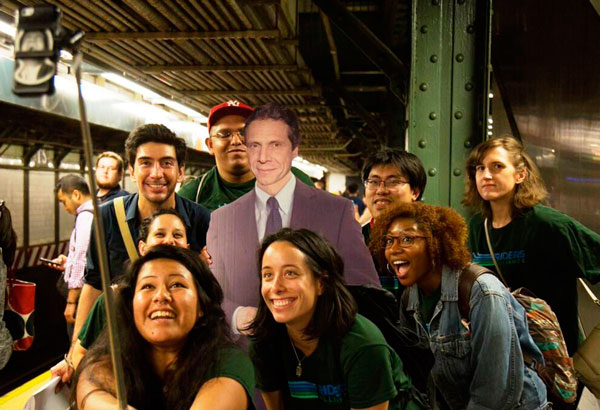
Nick Sifuentes is Deputy Director of New York City’s Riders Alliance, a grassroots organization of subway and bus riders fighting for stronger investment in New York’s public transit. The Riders Alliance is a member of the Bus Turnaround Coalition alongside TransitCenter, NYPIRG’s Straphangers Campaign, and the Tri-State Transportation Campaign. The Coalition has offered policy recommendations to achieve high quality, fast and reliable bus service for the 2.5 million daily bus riders in New York City. He speaks here about Rider’s Alliance’s campaign model, which is replicable by transit advocacy groups working anywhere in the country.
TransitCenter: Tell us about New York’s buses and the Bus Turnaround Campaign.
Nick: New York’s buses are really slow. On average, they travel about 7 miles an hour, and they’re getting slower as the streets become more congested with car traffic. In fact, with a good pair of walking shoes, I can easily beat some of the buses in Midtown Manhattan or Downtown Brooklyn. In some areas, this is because stops are spaced too closely, buses get stuck in traffic, or routes are simply too indirect.
For years, Riders Alliance has organized bus riders for improvements on individual lines, but we’ve never had the technical chops to say, for example, “Hey, this street is perfect for bus lanes.” Partnering with a research organization like TransitCenter, along with the Straphangers Campaign and Tri-State Transportation Campaign, has complemented our ability to organize riders with a technical skillset we lacked.
We’ve offered a set of policy ideas to get buses moving quickly and reliably again. These are simple things like having riders board through every door or straightening out routes that haven’t changed since the streetcar era. The good news is these improvements can be rolled out in months or years, not decades.

TransitCenter: How does Riders Alliance structure campaigns like Bus Turnaround?
Nick: It’s important to work as many angles as possible when you’re trying to move the needle on public policy. We structure our campaigns around a silly acronym, B.L.E.R.P., which represents the elements we think are critical for running successful campaigns.
The “B” stands for base-building. That’s when we go out to talk to riders on bus stops or train platforms and get them excited about getting involved. Believe me, when a stop is full of frustrated people waiting for the bus, folks will want to gripe a bit. People get upset when their buses are delayed or crowded, and it’s our job to channel frustration into action. Few people know they can actually do something about their awful commutes.
The “L” is leadership development. This is when volunteers take ownership of our campaigns. They’ll help with political strategy, organize press events, or even become spokespeople or visit their elected officials. Most of our volunteers are just moms or grandparents, ordinary folks who don’t think about transit beyond getting to work or picking up the kids—yet some of our best ideas come from members like these.
The “E” represents elected officials. Elected officials can champion street improvements in their districts — or they can serve as roadblocks to change. Local politicians are very responsive to constituents who speak up on neighborhood issues. That’s why we prep volunteers to ask their own elected officials for improvements. We also try to bring facts in addition to personal narratives to bear in these meetings. For instance, this week we released district-level bus service report cards so both constituents and elected officials can evaluate the poor service performance of their buses.
The “R” is building relationships. This means partnering with allied groups who bring new capacities to our campaigns or whose work intersects with ours. Sometimes great partnerships aren’t apparent at first. For example, who knew legal assistance groups would be interested in transit issues? Groups like the Bronx Defenders and Brooklyn Defender Services have become strong partners on our Fair Fares campaign for half-priced MetroCards as a way to reduce the arrests of lower-income riders due to fare evasion.
And finally, the “P” stands for press coverage, which is essential to get our message out. We have a three-part rubric to get the press to care about our issues. The first is offering genuinely newsworthy information: a fresh perspective or new data. The second is having compelling personal stories from folks can talk about how they’ve been affected by a problem like poor bus service. The third element is spectacle. One of our all-time most successful press events involved a cardboard cutout of Governor Andrew Cuomo. We sent him on an “Apology Tour” through the subways, apologizing to riders for the sorry state of transit funding. This was our members’ idea; I take zero credit.
I think B.L.E.R.P. is a model that’s replicable by anyone, whether a professional organization like Riders Alliance or just group of volunteers who care passionately about winning transit improvements.
To get involved with Riders Alliance, visit ridersny.org
 On the Brink: Will WMATA’s Progress Be Erased by 2024?
On the Brink: Will WMATA’s Progress Be Erased by 2024?
The experience of being a WMATA rider has substantially improved over the last 18 months, thanks to changes the agency has made like adding off-peak service and simplifying fares. Things are about to get even better with the launch of all-door boarding later this fall, overnight bus service on some lines starting in December, and an ambitious plan to redesign the Metrobus network. But all of this could go away by July 1, 2024.
Read More A Bus Agenda for New York City Mayor Eric Adams
A Bus Agenda for New York City Mayor Eric Adams
To create the “state-of-the-art bus transit system” of his campaign platform, Mayor Adams will have to both expand the quantity and improve the quality of bus lanes. We recommend these strategies to get it done.
Read More